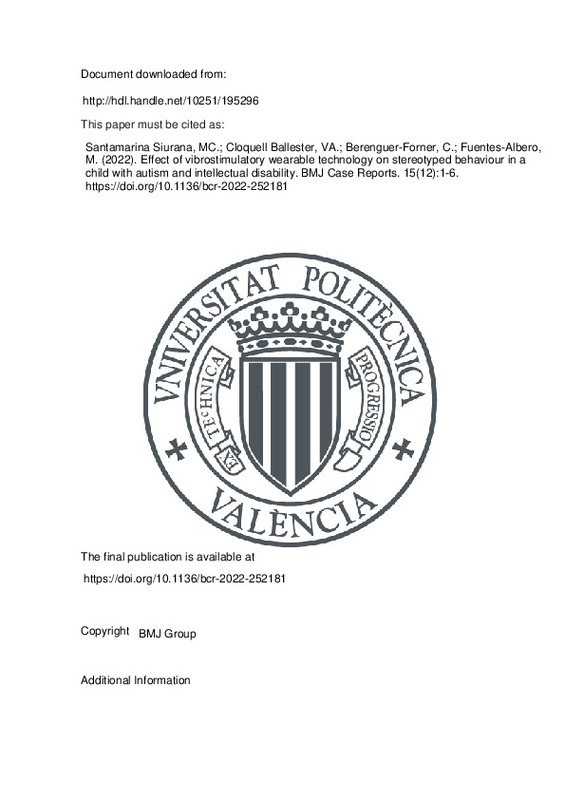JavaScript is disabled for your browser. Some features of this site may not work without it.
Buscar en RiuNet
Listar
Mi cuenta
Estadísticas
Ayuda RiuNet
Admin. UPV
Effect of vibrostimulatory wearable technology on stereotyped behaviour in a child with autism and intellectual disability
Mostrar el registro sencillo del ítem
Ficheros en el ítem
| dc.contributor.author | Santamarina Siurana, Mª Cristina
|
es_ES |
| dc.contributor.author | Cloquell Ballester, Vicente Agustín
|
es_ES |
| dc.contributor.author | Berenguer-Forner, Carmen
|
es_ES |
| dc.contributor.author | Fuentes-Albero, Milagros
|
es_ES |
| dc.date.accessioned | 2023-07-20T18:01:59Z | |
| dc.date.available | 2023-07-20T18:01:59Z | |
| dc.date.issued | 2022-12 | es_ES |
| dc.identifier.uri | http://hdl.handle.net/10251/195296 | |
| dc.description.abstract | [EN] The aim of the work has been to report on the effects of vibrostimulation, administered through wearable technology, on stereotyped behaviour of a child in middle childhood, with autism, intellectual disability and severe behaviour in the 'stereotypic behaviour' subscale of the Restricted and Repetitive Behaviour Revised Scale. He received vibrostimulation (210 Hz, 2.8 mu m), with a continuous pattern of vibration: three vibrations of 700 ms, each separated by a rest period of 500 ms and a pause of 8000 ms. Vibration was delivered bilaterally by two devices, repeating the vibration pattern for 3 min. The measures were repeated four times alternately, with the device turned off and on. The outcome measure was frequency of stereotyed behaviour, which was evaluated for 3 min with and without vibrostimulation. The results and observations, over 3 min of stimulation, showed the disappearance of stereotyped movements during vibrostimulation and better precision in intentional hand movements. Subjectively, the child enjoyed vibrostimulation. | es_ES |
| dc.language | Inglés | es_ES |
| dc.publisher | BMJ Group | es_ES |
| dc.relation.ispartof | BMJ Case Reports | es_ES |
| dc.rights | Reconocimiento - No comercial (by-nc) | es_ES |
| dc.subject | Health informatics | es_ES |
| dc.subject | Movement disorders (other than Parkinsons) | es_ES |
| dc.subject | Developmental paediatrocs | es_ES |
| dc.subject | Child and adolescent psychiatry | es_ES |
| dc.subject.classification | PROYECTOS DE INGENIERIA | es_ES |
| dc.subject.classification | INGENIERIA DE LA CONSTRUCCION | es_ES |
| dc.title | Effect of vibrostimulatory wearable technology on stereotyped behaviour in a child with autism and intellectual disability | es_ES |
| dc.type | Artículo | es_ES |
| dc.identifier.doi | 10.1136/bcr-2022-252181 | es_ES |
| dc.rights.accessRights | Abierto | es_ES |
| dc.contributor.affiliation | Universitat Politècnica de València. Escuela Técnica Superior de Ingenieros Industriales - Escola Tècnica Superior d'Enginyers Industrials | es_ES |
| dc.contributor.affiliation | Universitat Politècnica de València. Escuela Técnica Superior de Ingeniería del Diseño - Escola Tècnica Superior d'Enginyeria del Disseny | es_ES |
| dc.description.bibliographicCitation | Santamarina Siurana, MC.; Cloquell Ballester, VA.; Berenguer-Forner, C.; Fuentes-Albero, M. (2022). Effect of vibrostimulatory wearable technology on stereotyped behaviour in a child with autism and intellectual disability. BMJ Case Reports. 15(12):1-6. https://doi.org/10.1136/bcr-2022-252181 | es_ES |
| dc.description.accrualMethod | S | es_ES |
| dc.relation.publisherversion | https://doi.org/10.1136/bcr-2022-252181 | es_ES |
| dc.description.upvformatpinicio | 1 | es_ES |
| dc.description.upvformatpfin | 6 | es_ES |
| dc.type.version | info:eu-repo/semantics/publishedVersion | es_ES |
| dc.description.volume | 15 | es_ES |
| dc.description.issue | 12 | es_ES |
| dc.identifier.eissn | 1757-790X | es_ES |
| dc.identifier.pmid | 36585047 | es_ES |
| dc.identifier.pmcid | PMC9809298 | es_ES |
| dc.relation.pasarela | S\491658 | es_ES |
| dc.subject.ods | 03.- Garantizar una vida saludable y promover el bienestar para todos y todas en todas las edades | es_ES |







![[Cerrado]](/themes/UPV/images/candado.png)

